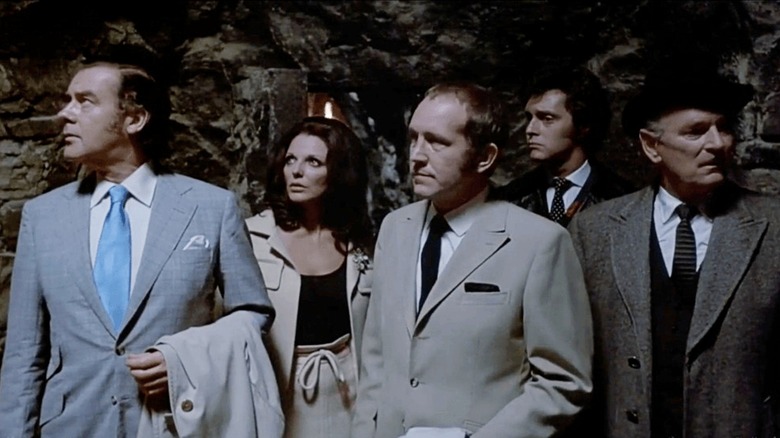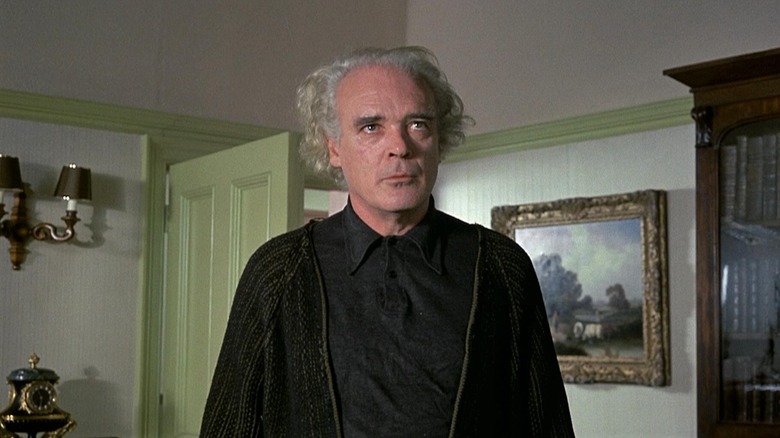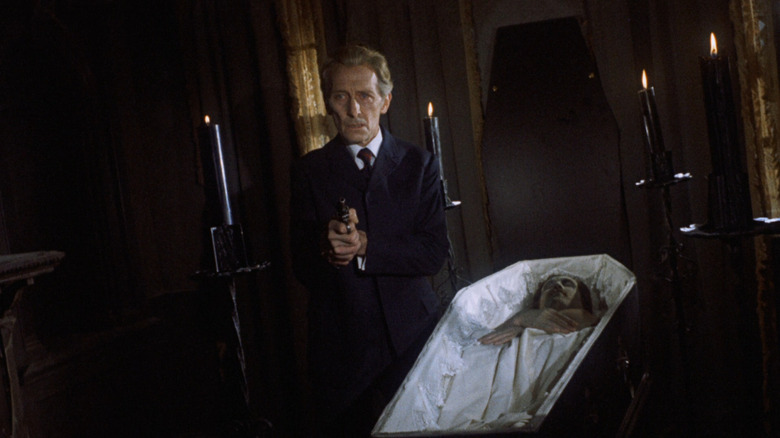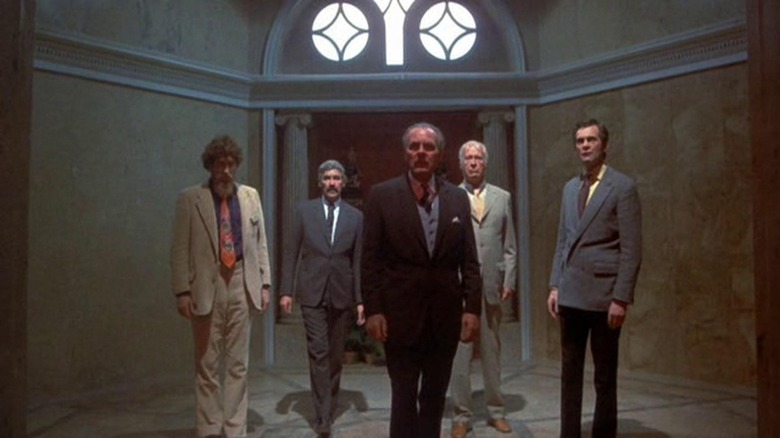The Daily Stream: These Amicus Anthologies Are A Must-Watch Marathon For Film Buffs
(Welcome to The Daily Stream, an ongoing series in which the /Film team shares what they've been watching, why it's worth checking out, and where you can stream it.)
The Movies: "The House That Dripped Blood," "Tales from the Crypt," "Asylum," and "The Vault of Horror"
Where you can stream them: Tubi
The Pitch: Every October, as streaming services fire up their spookiest programming, a thirst arises for digestible, fun horror anthologies. The most-cited gold standards for these collections are George A. Romero's 1982 classic "Creepshow" and the '90s-dominant HBO series "Tales from the Crypt," among others. What has gone long-unacknowledged is a series of horror anthology films arriving partway between those genre classics and the comic books that directly inspired them, courtesy of the England-based Amicus Productions.
This writer has dedicated some praise to "Asylum," Roy Ward Baker's 1972 anthology featuring a mechanized blade-wielding mini-Herbert Lom. But after discovering that the following films are all accessible on Tubi's streaming app, it's time to blow the Amicus conch shell and welcome film enthusiasts to broaden their cinematic horizons with the predecessors to their scary anthology faves.
One could say that the Amicus movies were the gradual product of World War II. Coming into the 1950s, Americans would confront themes of mass annihilation and enemy infiltration through fringe extremes like UFO mania and McCarthyism-borne distrust (which would distill itself into cynical showcases like "The Monsters Are Due on Maple Street" episode of Rod Serling's original series "The Twilight Zone"). According to scholar David J. Skal in his horror genre chronicle "The Monster Show," by 1953, "more Americans were reading horror comics than were reading 'Reader's Digest' or 'The Saturday Evening Post,'" and from then, the Entertaining Comics (E.C.) Group launched the biggest wave of imitators in the Atomic Age. Their most retold works include "Tales from the Crypt," "The Vault of Horror," and "The Haunt of Fear," with tried-and-true personal vengeance tales and Monkey's Paw variations. In the following movies, Death is the great equalizer — the only way to deliver true justice to wrongdoers.
The House That Dripped Blood (1971)
The wraparound: Detective Inspector Holloway (John Bennett) arrives from Scotland Yard to investigate the disappearance of film star Paul Henderson ("Doctor Who" star Jon Pertwee) from his isolated country house. Holloway learns of the home's strange history, occupant by doomed occupant.
Why it's essential viewing: First up is "The House That Dripped Blood," directed by Peter Duffel in his only Amicus production. Released in 1971, it's one of the Amicus crop's tamest anthologies, with plenty of star power (Peter Cushing! Ingrid Pitt! Christopher Lee!) filmed in crisp Eastman Color to keep things interesting. Each house occupant's story is crafted by Robert Bloch, known for writing the novel that would inspire Alfred Hitchcock's "Psycho." In his reflective book on horror, "Danse Macabre," author Stephen King regards the legacy of weird fiction publisher Arkham House, also known as the unit that first published H.P. Lovecraft's works in hardcover. Arkham's "most important works," King claims, arrived "in the period 1939-1960 — works including 'The Opener of the Way' and 'Pleasant Dreams' by Robert Bloch."
Some of Bloch's stories find their way into the blood-dripped house, the most entertaining being "Sweets to the Sweet," originally published in the March 1947 volume of post-war pulp mag "Weird Tales." Therein, moody widower John Reid (Christopher Lee) moves into the house of the title, along with his cherubic but pyrophobic daughter Jane (Chloe Franks). Hired tutor Ann Norton (Nyree Dawn Porter) suspects an abusive relationship between the two. She helps the girl overcome her fear of fire and teaches her to read, both of which catalyze Jane's emancipation — with disastrous results to be filed under "good for her."
Tales from the Crypt (1972)
The wraparound: Five strangers (Joan Collins, Ian Hendry, Robin Phillips, Richard Greene, and Nigel Patrick) touring a crypt cross paths with the Crypt Keeper (Ralph Richardson), who warns of each person's respective gruesome death.
Why it's essential viewing: Directed by seasoned Hammer horror director Freddie Francis, "Tales" is the highest-regarded Amicus collection and a bridge between the EC Comics heydey and its great echo in the era of "Tales from the Crypt" and Romero's "Creepshow." It kicks in the door with the sacrilegious holiday delight "...And All Through the House," which disrespects Christmas with a naughty Joan Collins ("Goonies" mom Mary Ellen Trainor would assume the role in the HBO series' episode of the same title), who finds herself at the mercy of a filthy escaped maniac dressed as Saint Nick. There's something subversive in watching Collins, with a full roller set teased to the moon and jewelry clanking like sleigh bells, scooping up blood with a silver cake server and pouring it into a champagne glass.
"Poetic Justice" features one of the most mean-spirited characters among the films listed: a rich snot (Robin Phillips) who conjures up a smear campaign against the sweetest character Peter Cushing has ever played. That's when the segment's title activates, in a bloody moment that predates a similar death in "My Bloody Valentine" by nearly a decade.
The collection's peak is in its final segment, "Blind Alleys" — an old-fashioned tale of secular street justice, no occult shenanigans needed. Major William Rogers (Nigel Patrick) is the tyrannical new director of a men's home for the blind. When his penny-pinching callousness results in the death of one of the men, the others enact swift and sweet punishment led by Patrick Magee, tapping into a sliver of the fury he'd channeled in "A Clockwork Orange" the year prior.
Asylum (1972)
The wraparound: "Asylum" might be considered the outlier of this film crop in its premise, which delivers each segment story via its raving survivors, all patient at an grand, isolated asylum "for the incurably insane." To secure a position as the new doctor there, Dr. Martin (Robert Powell) arrives and is given a test: interview patients and determine which is the psychotic former head of the asylum.
Why it's essential viewing: "Asylum" is a well-oiled product of the Amicus anthology machine; its July UK premiere arrived only three months after shooting wrapped. Roy Ward Baker had the bona fides to helm the picture, as it was his adaptation of BBC's "Quatermass and the Pit" series that became the launchpad for Hammer Film Productions' ascent throughout the 1960s and 70s. Favored Rifftrax target Milton Subotsky produces with a script from "Psycho" scribe Robert Bloch, who adapts four of his own short stories.
Among them, "Weird Tailor" stands beyond the EC Comics-siphoned tales for its largely innocent protagonist Bruno (Barry Morse), an elderly tailor whose debts threaten his livelihood. Peter Cushing gets complex as a customer who arrives to Bruno's shop with an unorthodox order for a suit to be sewn during witching hours only. Bruno desperately accepts, and when the commissioned suit is finally put to use, Doug Gamley's score gallops into gear with horns loud enough to make you forget that you knew of Bruno's assured survival going in.
"Asylum" would be a notable stop along the way of the Me Decade's indulgence in the inmates-run-the-asylum subgenre of the psycho-movie. The end of the '70s would see distrust in psychiatry via Stacy Keach's unorthodox therapy in "The Ninth Configuration," and had a foothold in the Oscar-winning "One Flew Over the Cuckoo's Nest" and William Friedkin's "The Exorcist." "Asylum" remains a blind spot in that subgenre for many.
The Vault of Horror (1973)
The wraparound: Aboard a descending elevator, five men (Daniel Massey, Terry-Thomas, Curd Jürgens, Michael Craig, Tom Baker) meet for the first time. At their destination — a fancy underground lounge room – the drinks and stories flow as each man tells of his recurring nightmare.
Why it's essential viewing: Another Roy Ward Baker special, "The Vault of Horror" showcases several stories written by producer Milton Subotsky himself, culled largely from the EC-based "Tales from the Crypt" comics of the 1950s. It's certainly the bloodiest of the lot; a man's jugular is punctured in one segment (it's blacked out if you have a namby-pamby US release of the film), and a domineering husband takes a hammer to the dome onscreen. The majority of the stories observe a classic plot seen in the likes of "Tales from the Crypt's" skin-melting episode "Forever Ambergris" and Stephen King's "Creepshow" segment "The Lonesome Death of Jordy Verrill," of ambitious men who get their hands caught in the cookie jar, usually by the cardinal cosmic horror sin of messing with otherworldy things man can't comprehend.
The highlight story doesn't come from the "Vault of Horror" EC pool, but from its early-1950s sister line "Shock SuspenStories." "The Neat Job" stars Terry-Thomas (the gap-toothed Lt-Colonel J. Algernon Hawthorne of "It's a Mad, Mad, Mad, Mad World") as the neurotic and neat Arthur Critchit, who takes Eleanor as a trophy wife. Eleanor is played by Glynis Johns, who belted out "Sister Suffragette" as Winifred Banks in Disney's "Mary Poppins," and her character is no less put-upon in "Asylum." The relatively younger wife is expected to keep a tidy home, but hubby's obsession drives her to the edge of sanity. Freddie Francis' absence is felt in one of the more uneven but just as enjoyable anthologies.




